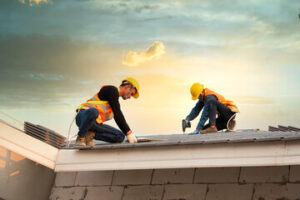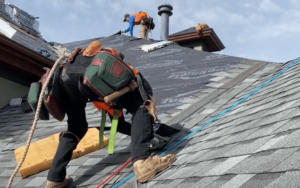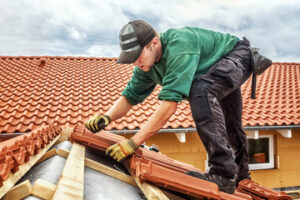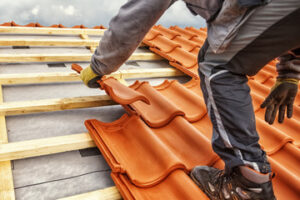Your roofers will lay an ice and water barrier or leak barrier (if it isn’t already there). Next, they’ll run underlayment over the leak barrier and drip edge for added protection.

The roofing process can be noisy, so you may want to relocate sensitive pets or children during the work hours. Open communication with your contractor is key to keeping everyone happy and safe throughout the project. Visit https://www.jmelitecontractors.com to learn more.
There are many different roofing materials on the market. Homeowners will often choose their roofing material based on cost, durability against harsh weather conditions and aesthetic appeal that matches local architectural styles.
Asphalt shingles are the most common roofing material in modern homes. They are composed of a fiberglass base coated in asphalt and embedded with mineral granules. They are easy to install and available in a variety of colors and thicknesses to suit many architectural designs.
Metal roofing is another option for homeowners. This type of roof can last for a long time, but it is not suitable for every home. It can be noisy during storms, and the panels can weigh down the structure of the building if they are not properly supported.
Concrete is a durable roofing material that can mimic the appearance of shingle and tile roofs. It is also affordable and has a decent life expectancy of 50 years or more. However, concrete is heavy and may require extra support if the roof is on a high-rise building.
Slate is a popular roofing material used on luxury homes and historical buildings. It is formed by forming clay into specific shapes and firing them at high temperatures. Slate is a beautiful roofing material that can add a touch of class to your home, but it can be expensive. Slate is also difficult to work with and requires a specialist to install.
Other roofing options include membrane and rolled roofing. Membrane roofs are made from rubber or plastic and offer excellent waterproof protection. They are usually more affordable than shingle or tile roofs, but they do not provide as much insulation. Rolled roofing is a more durable option that offers better insulation and lasts longer than membrane roofs.
The next layer of the roof is called the underlayment. This is a specialized material that protects vulnerable areas of the roof from water infiltration and ice damage. It is typically installed in roof valleys, around penetrations and on low-pitched roofs. It is self-sealing and prevents leaks by creating a barrier that seals around nails. In regions above the snow line, building codes typically require two rows of ice and water shield along the roof edges to combat ice dams.
Installation Methods
Roofers use a variety of tools and techniques to install your new roof. They may start by laying underlayment. This material acts as a barrier between your roof and the shingles to prevent water penetration. It also helps protect the roof sheeting from the elements and adds fire resistance. Roofers lay the underlayment in courses, with each layer overlapping the one before it. They then fasten the underlayment with cap nails above the drip edge.
After the underlayment is in place, your roofer can begin laying the shingle courses. They may start with starter shingles, which are half as wide as regular shingles and help the first rows line up correctly. They will then cover the starter shingles with a protective underlayment, such as felt paper or tar paper. The underlayment also helps prevent leaks by covering the bare wood of the roof deck.
Next, your contractor will install the ice and water barrier or leak barrier. This material is laid over the sheathing to protect it from moisture and ice dams. It is typically fastened to the existing drip edge for added protection.
Once the ice and water barrier is in place, your roofing contractor will install the underlayment. The underlayment will be run over the ice and water barrier and the drip edge to protect it from moisture. It will be fastened with cap nails above the drip edge for extra strength and protection.
The valleys of your roof, where the slopes meet, need special attention to prevent leakage. Your roofer will waterproof the valleys using underlayment and felt paper, with different methods that allow for the specific structure of these areas.
If you have skylights, chimneys, vents, or other structures on your roof, the roofer will install flashing to prevent leaks around these items. The flashing is a thin metal piece that covers cracks and gaps in the shingles.
If you are having a roof installed, it is important to clear the area around your house for the work. The hammering and movement on the roof can cause damage to furniture, plants, and other items on or near your home. You may want to move things like your cars, outdoor gear, or storage bins to prevent them from getting damaged during the process.
Quality Control and Inspection
Throughout the course of a roofing project, it’s important to inspect work on a regular basis. This will help ensure that any potential issues are addressed quickly and effectively, resulting in a high-quality finished product. In addition, it will allow for any necessary corrections to be made before the end of the job, preventing costly errors or delays down the road.
Inspection procedures for roofing installation are complex and detailed, often requiring extensive training. This is especially true for roofing contractors, who must find the right balance between thorough inspections and efficient production. In a fast-paced industry, striking this balance is critical to ensuring quality outcomes while maintaining profitability.
A successful roofing project depends on the quality of the materials used. Therefore, it is vital that a quality control inspector verify all materials used on a roofing project are delivered with proper documentation. Additionally, they must ensure that all materials are stored properly on site and that no damaged or obsolete materials get used in the project.
In addition to inspecting all materials, a roofing contractor should also conduct comprehensive final inspections to ensure the roof is installed per industry standards and manufacturer specifications. These final inspections will include checking that all roofing materials are securely attached to the structure, all flashing is properly installed and sealed, and that insulation and ventilation requirements have been met.
Lastly, it is important to ensure that all employees on the roofing crew are familiar with company standards and procedures. This can be done by establishing standard operating procedures (SOPs) that can be followed by all members of the roofing team. SOPs will make sure that every project is completed according to the same high level of quality, regardless of which employee is working on the jobsite.
If you’re looking for a qualified and reliable roofing inspection company, be sure to choose one that has a track record of success and is accredited by the National Roof Certification and Inspection Association (NRCIA). This accreditation ensures that your chosen inspector adheres to rigorous industry standards and has the expertise required to perform accurate and thorough roofing inspections.
Final Inspection
Once all of the construction is complete and ready for the final inspection, the roofing crew will perform a thorough cleanup of the work area. This is to ensure that all the nails are retrieved, and that the roof has been cleaned thoroughly of any debris or left-over materials from the construction process. In addition, the roofing team will have to make sure that all of the existing or new solid sheathing has been nailed properly and that no shingles are missing or damaged. They also will check that the drip edge and flashing are properly installed, which is a critical step to prevent water leaks into the structure. The inspection will include a look at the roof’s valleys, vents, and chimneys to ensure that they are sealed properly. The final inspection will also include a look at the exterior grade and wall caulking to ensure that water is properly diverted away from the building.
The final inspection is an essential part of a successful construction project. It is the last chance to address any issues, and it is the final check that will be performed before a building can be declared as completed and ready for occupancy. To help ensure a successful final inspection, contractors should understand the processes involved, and they should have systems in place to keep track of all necessary paperwork, inspections, and approvals. In addition, they should create organizational systems to keep track of all documentation and ensure that it is properly filed.
Skipping a final inspection can be incredibly costly to a construction project. Potential buyers are often wary of properties with open permits or missing inspections, and even if they aren’t, insurance companies will usually refuse to cover damage caused by uninspected work. Additionally, many lenders won’t even consider giving a mortgage for a property that doesn’t have the proper inspections.



